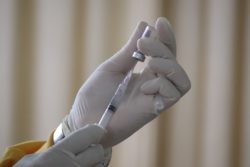Lupron or Leuprolide is prescribed regularly for endometriosis, fibroids and undiagnosable pelvic pain. The evidence supporting its use is sketchy at best. Perhaps the most troubling practice is the use of Lupron to ‘diagnose’ endometriosis, an indication for which there is little evidence.
Can Lupron Response Indicate Endometriosis?
According to a report by the Practice Committee for Reproductive Medicine, No.
“The gonadotropin-releasing hormone (GnRH) agonist Lupron has been advocated to diagnose and treat endometriosis without performing laparoscopy, based primarily on the results of one study involving 95 women with moderate to severe chronic pelvic pain unrelated to menstruation. In this study, participants were randomized to receive depo-leuprolide 3.75 mg or placebo injection monthly for three months followed by laparoscopy. The underlying premise was that improved pain symptoms during the hypoestrogenic state induced by GnRH agonist treatment might reliably indicate that endometriosis was the cause.”
What the research found, belies the utility and subsequent marketing of using Lupron to diagnose endometriosis. Pain relief in response to Lupron was not significantly different in those who did or did not have detectable endometriosis at laparoscopy (81.8% vs. 72.7%, respectively). That means, even by the company’s own research the response to Lupron did not and could not accurately diagnose the endometriosis.
Do I Really Need Laparoscopy to Diagnose Endometriosis?
“My doctor said that if I get better on Lupron it means that I have endometriosis. He said I might as well take Lupron now and not wait for the laparoscopy.” In other words, is the currently popular practice of using a GnRH agonist (e.g. Lupron) as a treatment for endometriosis without doing a laparoscopy first warranted? No, it is not and here’s why.
Lupron pre-laparoscopy has become common practice since the publication of a study by the drug’s manufacturer (no bias there) several years ago. The study showed that 82% of women with pelvic pain that had not responded to milder pain medications or antibiotics were shown to have endometriosis. When Lupron was given and the ovaries temporarily shut off, pain improved. However, pain was also reduced in the women who did not have endometriosis. This happens because hormones made by the ovaries influence pain perception. Therefore, if pain gets better after Lupron is given, it does not necessarily mean that the pain is due to endometriosis. Failure to understand how hormones, pain, endometriosis and Lupron interact leads to an incorrect diagnosis in at least 25% of cases. In addition, many forms of endometriosis do not respond to this drug. Its expense and high level of side effects (e.g. rapid loss of bone calcium) also make it a drug to be used with caution. Our experience is that using the drug before doing a laparoscopy most often delays, but does not eliminate, the ultimate need for laparoscopy.
Is Laparoscopy the Only Way to Diagnose Endometriosis?
Yes. Laparoscopic inspection of the pelvis is the gold standard for diagnosis of endometriosis. There is evidence in abundance qualifying the need for laparoscopic inspection to confirm the diagnosis – and effective treatment of – endometriosis. A non-invasive diagnostic test would be especially useful in the endometriosis and gynepathology community, indeed; however, despite ongoing research and development of many, many such potential tests and markers, not a single one has achieved benchmark and can be relied upon to diagnose endometriosis accurately. Moreover, medical therapy, like Lupron should not be used as evidence of a diagnosis. Medical therapy has never ‘cured the disease’. Medical therapies like Lupron are used merely to temporarily suppress some of the symptoms associated with endometriosis; it is neither long-lasting nor wholly effective, and it is not without serious side-effects.
Are all Laparoscopic Techniques the Same?
No. You will need to find an expert in laparscopic excision for endometriosis. Meticulous laparoscopic excision (LAPEX), has significantly superior results to not only obtaining diagnosis through histological confirmation, but also to removing disease effectively while preserving healthy tissue and organs. Some specialty centers have rates as low as 7-10% recurrence in their patient populations as far as 20 years out from initial excision. The recurrence rate for ablation and vaporization, on the other hand, are very high – ranging around 40-60% within the very first year following surgery; some as high as 77% within the first 2 years. Superficial ablation and other topical removal of only obvious lesions results in disease left behind and in many cases, depositing carbon which can be painful on its own – as well as be confused for endometriosis at later surgical re-intervention [Nezhat et al.].
Of course; it goes without saying – all of this notwithstanding: what matters most is whether the patient is adequately relieved of her pain. For that, Lupron is most certainly not indicated.
Lupron Side Effects Survey
To determine the rate, range and scope of side-effects associated with Lupron use in women’s health, Lucine Health Sciences and Hormones Matter are conducting an online survey: The Lupron Side Effects Survey. The survey is anonymous and takes only 15 minutes to complete. If you are woman who has ever been prescribed Lupron, please take a few minutes to complete the survey. Your data will give other women the information they need to make a decision about Lupron.
About the Authors: The Center for Endometriosis Care is a COEMIG-Designated Center of Excellence in Minimally Invasive Gynecologic Surgery which was founded over two decades ago by renowned laparoscopic excision (LAPEX) pioneer Robert B. Albee, Jr., MD, FACOG, ACGE. The Center is run under the leadership of Medical Director Ken R. Sinervo, MD, FRCSC, ACGE along with a caring, compassionate staff. We continue our efforts as architects of the legacy in gold standard endometriosis care.





